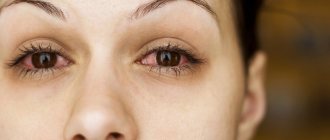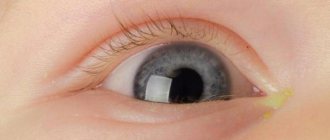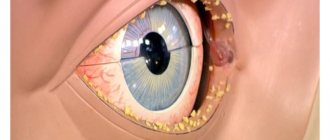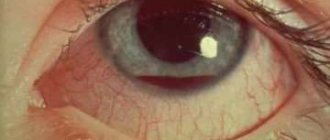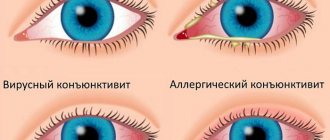Why does the skin around the eyes become red?
There are many reasons and it is important not to make mistakes when identifying them.
Any cosmetic product, especially eyelid skin care, has its own structure, each component of which can cause an allergic reaction. These can be biological additives, fat base, flavorings and other components.
If, several hours (up to a day) after use, redness of the skin around the eyes appears, this is most likely caused by individual immunity to the new product. Often this reaction is combined with lacrimation, swelling and itching.
An allergic reaction of the eyelids can be provoked not only by eye skin care products, but also by the entry of the allergen into the body through other routes:
- For taking medications;
- Food components;
- Plant pollen;
- Poultry down or feathers;
- Animal wool;
- House dust and others.
In this case, redness is caused by increased synthesis in the body of histamine, a substance responsible for the so-called fight of the body against a foreign allergen.
The third cause of redness may be infection on the conjunctiva of the eyes. These can be staphylococci, streptococci, Pseudomonas aeruginosa, Klebsiella, viral agents, protozoan microorganisms.
As a result of their pathogenic effects, or rather, the products of their vital activity, the upper layer of the epithelium experiences a destructive effect. Elementary redness can turn into an inflammatory process with the formation of purulent discharge and the development of intoxication of the entire body.
Could redness of the eyelids be the result of diseases of the internal organs?
This is exactly the question that comes to a person if, upon waking up in the morning, he cannot associate such a symptom with taking medications, using new care products, and accidentally getting dirt into his eyes (this is not always noticeable).
Drug treatment
The general principles of treatment in this case boil down to the following actions:
- Treatment of the arch of the eyelids with alkaline solutions and antiseptics - in order to prevent the development of secondary microflora in the inflamed areas of the eyes;
- Instillation and placement (in the form of drops and ointments) into the conjunctival cavity of antibiotics and corticosteroids - to eliminate pathogenic microflora and relieve the inflammatory process;
- The use of tear substitutes (for dry eye syndrome);
- For demodicosis, use local medications containing antiprotozoal substances.
Causes
The appearance of redness around the eyes can be due to a number of reasons. In order to accurately prescribe medications, it is necessary to diagnose the causes of such a reaction.
Rosacea
Diagnostic methods
A selection of videos will help you understand the symptoms of redness on your own.
Why do my eyes and the skin around them turn red? The reasons are:
- allergy;
- negative environmental impact;
- perioral dermatitis;
- eye rosacea;
- general infectious diseases;
- blepharitis;
- internal disorders of the body;
- other reasons.
Redness of the skin around the eyes in most cases indicates an allergic reaction. The reason may be poor-quality cosmetics that are applied to this area: mascara, eye shadow and eye creams.
Other irritants can also cause swelling: food, household chemicals, wool and dust, as well as water with which a person washes his face. The cause of redness around the eyes is often allergic rhinitis - the body's reaction to pollen or cigarette smoke. The main symptom is inflammation of the mucous membrane, but among the signs you can find inflammation of the skin around the eyes.
The epidermis in this area is prone to peeling. If a person has dry skin, then there is a high probability of redness after exposure to cold, heat or strong wind.
In addition, redness of the skin around the eyes is one of the main symptoms of dermatitis. The skin becomes dry, sensitive, and a feeling of tightness and burning appears.
Such inflammation can be caused by fluoride supplements or the use of corticosteroids.
- Eye rosacea - dilation of capillaries.
During this illness, the eyes itch, water, and a feeling of a foreign body appears inside. With an infection, redness is often located not only in this area, but throughout the body.
- One of these manifestations is conjunctivitis (inflammation of the mucous membrane of the eye).
This disease has many causes and subtypes, which can be determined by the attending physician. The most common symptoms include redness under the eyes, pain in the eyes, and sensitivity to bright light.
- Blepharitis is inflammation of the eyelash margin.
Eyelids turn red most often in people after 40 years of age, but recently the disease has also been observed in children. Inflammation is caused by bacteria, viruses and fungi. Redness is a consequence of the rapid proliferation of staphylococcus. Without timely treatment, the area around the eye begins to peel and itch.
Causes of eyelid inflammation
There are many factors leading to inflammation of this area, but often the causes of this defect are the following:
- Microscopic mite bite. These harmful insects prefer to breed on human skin and hair. And this happens due to decreased immunity.
- Increased sensitivity of the body to external factors. In this case, irritants can be low-quality cosmetics, pet hair and household dust.
- If you have farsightedness, the eye muscles will be constantly tense. As a result, a person experiences itching, so he begins to rub his tired eyelids. At the same time, thin skin can easily become infected.
Diseases of the eyelids in humans can be a consequence of many other factors.
Problems with the digestive organs can cause metabolic disorders. Therefore, blepharitis is often diagnosed in the presence of gastritis, colitis and diabetes. These problems disrupt the functioning of the sebaceous glands , which are located between the eyelashes, which increases the likelihood of inflammation of the eyelids.
In addition, the cause of inflammation of this part may be:
- disturbances in the lacrimal layer of the ocular cornea;
- chronic viral diseases;
- streptococcus and staphylococcus of the eyeball membrane;
- chemical burns and sores on the eyelid;
- injuries;
- inflammatory processes in the sinuses and nasopharynx.
Inflammation under the eye and its types
There are not many types of inflammation in the eye area, and some of them can be easily cured at home, even without consulting a specialist. But this rule only applies if you are sure of the symptoms of the disease.
Conjunctivitis
Conjunctivitis is an inflammation of the gland that is connected to the lining of the eye. Conjunctivitis can be of three types: allergic, viral, bacterial, depending on the causative agent of the disease.
With such inflammation, the skin around the eyes turns red, this is associated with the development of inflammation. You can easily get rid of swelling under the eye - with medication or improvised means. But the cause of inflammation is almost impossible to eliminate without special medications.
So, in the case of allergic conjunctivitis, you need, first of all, to exclude the allergen itself and purchase antihistamines.
Accordingly, in the case of bacterial conjunctivitis, antibacterial agents are used, and in the case of viral conjunctivitis, antiviral agents are used.
As for swelling, an infusion of chamomile or strong black tea would be an excellent remedy. Take a cotton pad, soak it in the solution and wipe the sore eye several times a day.
It is also important to remember that under no circumstances should you use alcohol-based products to relieve swelling, since this can only harm the mucous membrane.
Barley
Stye is an inflammation of the eyelid that occurs when the follicle located at the root of the eyelashes becomes infected. It can be external or internal, but the more common form is an external stye.
The main symptoms of stye are pain, redness, foreign body sensations, and swelling.
Causes of blepharitis
When faced with this pathology for the first time, you need to clearly understand: it is not so much the symptoms of the disease themselves that need to be eliminated, but rather its root cause. That is why treatment of this disease must simultaneously begin both with the fight against its external manifestations and with identifying the causes of its occurrence.
Today, the origin of the disease can lie in infectious and non-infectious pathogens.
Causes of blepharitis:
- Staphylococcus infection;
- Herpes virus, shingles or molluscum contagiosum;
- Ingestion of pathogenic fungi or arthropods, which may include ticks or lice;
- Various inflammatory processes on the surface of the skin (eczema, seborrhea);
- Immunodeficiency.
According to statistics, the majority of patients are women between 30 and 50 years old who have blepharitis, which occurs as a result of a disease such as rosacea (rosacea). It is believed that the incidence of the pathology increases depending on age, although there is no guarantee that a young girl or man is not susceptible to this disease. Also, no one can guarantee that the disease will proceed without complications or relapses.
Symptom Definition
Symptoms of redness
Irritation under the eye is accompanied by the following symptoms:
- The appearance of redness;
- Swelling of the eyelids;
- Itching;
- Increased tear production;
- Dryness and flaking under the eyes.
Some symptoms of redness are similar to conjunctivitis. For an accurate diagnosis, advises obaglaza, you should contact an ophthalmologist and take a scraping.
The skin around the eyes may simply change color or swell (especially if the problem is allergic). Often, redness of the eyes is accompanied by burning, peeling, and lacrimation. Both the upper and lower eyelids turn red - separately or both at once, entirely or only individual parts of them.
Most often, the eyes not only turn red, but also itch, flake, and swell. The symptom may also manifest itself. If you have a red, scaly spot under your eye, this is a good reason to consult an ophthalmologist.
Treatment options
Treatment methods
After receiving an answer from the doctor to the question of why the eyelids turn red, they will prescribe treatment methods.
If the problems do not go away on their own, then medications, folk remedies, and making small adjustments to your everyday life will help remove the redness.
Exclusion of the stimulus
In case of allergies, redness of the skin under the eyes disappears after identifying the allergen. In this case, it must be eliminated from the patient’s routine. If you have allergies, you can take antihistamines, corticosteroids, or a variety of creams.
Treatment will be prescribed by a dermatologist or allergist after a thorough examination. To treat allergic rhinitis, mast cell membrane stabilizers and anticholinergic drugs are prescribed, since during rhinitis many chemical compounds together with histamine enter the bloodstream. This leads to a negative process.
To avoid inflammation after exposure to cold or heat, you should carefully protect the skin around the eyes with a scarf, hood or sunglasses, depending on the weather.
- For dermatitis, the skin around the eyes is thoroughly moisturized with creams containing a mixture of zinc and antibiotics. Many of them additionally relieve inflammation, discomfort and dryness. For this disease, corticosteroid ointments are contraindicated.
- Rosacea must be treated under medical supervision, since the components of treatment for eye irritation include antibiotics, immunomodulators and zinc oxide creams.
- In case of blepharitis, the patient should contact an ophthalmologist, who will prescribe a series of tests and additional studies. The therapy will be long-term. It consists of a complex of various ointments, antibiotics and antihistamines.
Hygiene of the eyelids and area under the eye plays an important role. The attending physician must demonstrate how to properly remove scales and crusts and the process of treating the affected area. Additionally, eyelid massage and diet are prescribed for the duration of therapy.
- Conjunctivitis is a contagious disease, so it is important to carefully follow all hygiene rules and be sure to have individual toiletries. Irritation around the eyes can be relieved with various antihistamines in the form of tablets, ointments or syrups for children.
In more advanced cases of the disease, steroid drops help, but they cause significant harm to the entire body and often cause dry mucous membranes. Their use should be minimal.
- In children, such redness can be caused by dry eye syndrome. It manifests itself during the first days of school. During this period, the eye often itches, since the child, who is not accustomed to heavy loads, is forced to constantly write, read and strain his eyesight.
In addition, while working at the blackboard, chalk dust often gets into your eyes. You need to teach your child to touch his face less, especially with dirty hands. Eye swelling is an unpleasant sign, so it’s worth knowing all the preventive measures.
The first thing you should do is rule out the presence of eye diseases. If they are, the doctor will prescribe treatment, which must be strictly adhered to. Infectious diseases are usually treated with antibiotic drops.
The treatment regimen for ophthalmological diseases is prescribed only by a doctor.
Suspect an allergy? Eliminate possible allergens and start taking antihistamines (tablets and/or gel). If antihistamines do not help with an allergic reaction, the doctor prescribes hormonal medications.
Traditional recipes that are safe and ideal for sensitive skin help relieve redness quite well. This:
- Parsley compresses - fresh herbs are cut as finely as possible, placed in gauze bags, which are then applied to the eyes for 10 minutes.
- Lotions with chamomile decoction - make a decoction from a pharmaceutical herb, soak cotton swabs in it and apply to your eyelids.
- Baking soda – prepare a weak soda solution, soak cotton swabs or gauze in it and place them on your eyes for 15 minutes.
- Compress with dill – dill should be used in the same way as parsley.
- Tea bags are a simple and quick way that is always at hand. To achieve maximum effect, place wet tea bags in the freezer for 5-10 minutes before use.
Chamomile has a pronounced drying effect, so it is better not to use it if the skin is peeling.
Please note that folk recipes help relieve redness, but do not cure. If the problem comes back again, be sure to consult a doctor.
Inflammation can begin due to skin damage from eyelash mites. In this case, it is unsafe to carry out independent treatment. Having identified the cause of inflammation, the doctor prescribes medications. At the initial stage of the disease, a specialist may recommend using Blefarogel or Demalan ointment. In addition, you will need to spend more time on eye hygiene. If the disease is advanced, then ointments are no longer enough. In this case, antibacterial drops must be used for treatment. These include erythromycin solution or sodium sulfacyl. Sometimes this type of inflammation is one of the signs of an allergy. Therapy should begin after identifying the allergen. As a rule, complex treatment is prescribed. This includes the use of antihistamines and creams containing mild corticosteroids. Inflammation caused by dry air, fatigue, too dim or, on the contrary, bright lighting can be eliminated with the help of ordinary lotions prepared from decoctions of medicinal herbs. A decoction of chamomile or string helps very well. You can also wipe inflamed skin with ice cubes from the same decoctions. If inflammation is caused by a lack of vitamins, then you should pay attention to what you eat. Most often, redness or peeling of the skin around the eyes is caused by a lack of B vitamins. Therefore, the menu should definitely include legumes, sea fish, dairy products, and liver. If inflammation occurs after using low-quality cosmetics, first of all, you need to thoroughly cleanse the skin. After this, it is advisable to make lotions from decoctions of chamomile, mint, parsley or dill. Thus, inflammation will be relieved and the skin will glow with health again. It is better not to use cosmetics that caused a negative reaction. If the cause of the inflammation cannot be determined, you can try to relieve the symptoms using the following recipe. Take a medium-sized potato, grind it into pulp and add 5 drops of olive oil. Stir the mixture. Next, take 2 pieces of sterile bandage and place a tablespoon of the mixture on each of them. Apply the lotions to the affected areas for 10 minutes. After time, rinse off the remaining mixture with cool water, and lubricate the skin around the eyes with olive or other vegetable oil.
Principles of treatment
When the first symptoms appear, the problem immediately arises: how to relieve inflammation from the eyes? There are traditional methods and folk remedies for the treatment of inflammatory eye diseases. Their goal is to destroy the pathogen, stop the inflammation process, and relieve pain.
Drug treatment of eye inflammation
Traditional medicine, first of all, recommends understanding the reasons that caused the inflammatory process.
If an allergic reaction is the cause of eye diseases, then the allergen must be removed immediately. Then rinse your eyes with plenty of boiled warm water. Apply local antiseptic eye drops (Visine, Okomistin). Take the following medications:
- sorbents (enterosgel, activated carbon, atoxyl);
- antihistamines (diazolin, suprastin, loratadine).
It is necessary to stop inflammation caused by viruses and bacteria with the help of antibacterial eye drops (erythromycin, chloramphenicol). Hydrocortisone ointment will help relieve the inflammatory reaction and relieve pain.
To combat demodex, use a cotton swab dipped in medical alcohol to remove crusts from the skin of the eyelids. Then apply blepharogel cream to the eyelids. Antibacterial drops (erythromycin) are instilled into the gas. For the purpose of disinfection, bedding and personal items are washed several times. Then iron it with a hot iron to prevent re-infection.
Traditional methods of treating eye inflammation
Together with traditional medicine, folk remedies are used for eye inflammation. In the initial stages, traditional methods become an excellent means of combating the inflammatory process. If the situation worsens, they are an addition to traditional treatment.
The first step is to stop exposure to the agent causing inflammation;
- household allergen intake;
- influence of physical or chemical factors;
- reduce the time you spend working with the computer.
Then you need to prepare a decoction that relieves inflammation. To do this, you need to brew mint, parsley, and chamomile as tea. Let it brew for half an hour. Drain the broth. Rinse your eyes with it and make a compress with sterile gauze for 15 minutes. The product perfectly helps to cope with the signs of inflammation in the initial stages.
When the first symptoms of an inflammatory eye disease appear, you should immediately contact an ophthalmologist. There is no need to self-medicate. This threatens to become chronic, spread the disease and cause loss of vision.
Treatment of inflammation of the skin around the eyes with folk remedies
First of all, it is worth remembering that folk remedies help reduce symptoms. It is unacceptable to use them as a separate treatment. A parsley compress will soothe irritated eyes.
To do this, you need to place fresh grass in gauze (it is better not to cut it, but to tear it with your hands) and apply it to the skin. Such lotions are good for removing dark circles under the eyes.
A decoction of chamomile or dill seeds will help with reddened skin. The grains are placed in cheesecloth and then in hot water. Chamomile ice will soothe the eyes and itching. To do this you need to pour 1 tbsp. plants with a glass of boiling water, and strain after half an hour.
Then the solution is sent to ice trays. When the product is ready, you can use it to wipe the irritated eyes several times a day. Chamomile ice relieves not only inflammation of the visual organ, but also redness and itching of the skin.
A decoction of dill will relieve swelling and soothe the irritated surface of the face. It is necessary to soak a cotton swab in the broth and place it on the eyelids. After it cools down a little, repeat the procedure. Using the same scheme, an infusion of cornflower is prepared (a glass of the plant per 2 tsp).
For skin diseases, a potato mask is suitable. The raw vegetable must be peeled and chopped using a grater, adding 1 tsp. olive oil.
Then you need to place the paste on several pieces of gauze and roll it up and apply it to the irritated eyes. After 10 minutes, the mask is removed by rinsing the skin with cool water or the decoctions described above.
How to relieve inflammation around the eyes at home?
In order to avoid inflammation, redness, peeling and other undesirable skin reactions to the environment, you just need to follow a few simple recommendations.
Homemade recipes for inflammation
https://www.youtube.com/watch?v=6FynqwmONSE
Often the cause of inflammation of the skin around the eyes is working for many hours at the computer, too dim or, on the contrary, bright lighting, and excessive dryness of the air in the room. In such cases, you can relieve inflammation around the eyes using simple lotions prepared with chamomile decoction.
In addition, you can significantly alleviate the skin condition by wiping it with a cube of frozen green tea, parsley decoction or cucumber juice.
Redness of the skin around the eyes can also be caused by a lack of B vitamins in the body. In this case, you need to supplement your diet with legumes, grains, sea fish, yeast, dairy products and liver.


